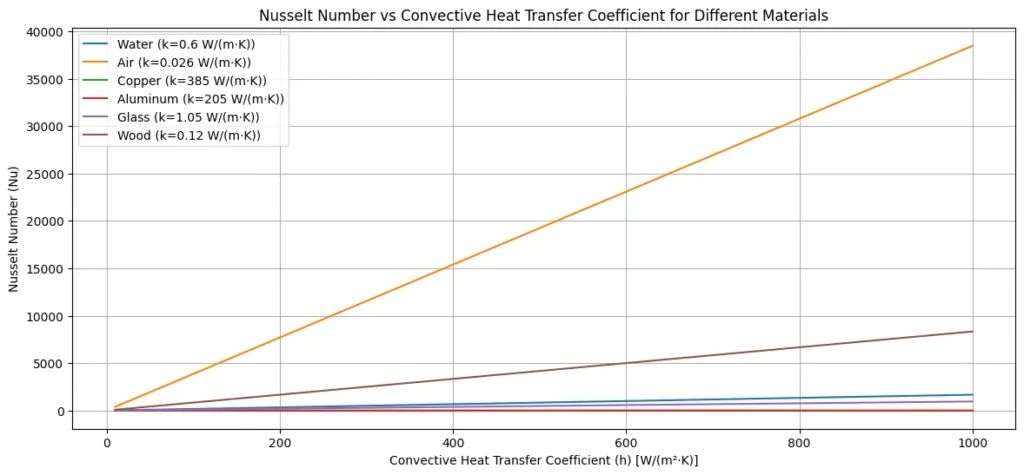Table of Contents
The Nusselt number Nu is a dimensionless number named after Wilhelm Nusselt, a German engineer. It is defined as the ratio of convective to conductive heat transfer across a fluid boundary.
Mathematically, Nusselt number is written as:
Nu = hL/k
where:
- h is the convective heat transfer coefficient (W/m²·K),
- L is a characteristic length (m),
- K is the thermal conductivity of the fluid (W/m·K).
Related: Hydraulic Diameter Calculator for Circular and Non-Circular cross-section
Related: Inverse Square Law for Radiation
Nusselt Number Calculator
This Calculator helps user to compute Nu, convective heat transfer coefficient, characteristic length L and thermal conductivity based on user selection. This online tool is useful for engineers and scientists working in the field of heat transfer or thermal-fluid sciences.
Related: Heat Transfer through Conduction Calculator – Fourier’s law
Related: Sieder-Tate Equation Solver for Heat Transfer Coefficient calculaton
Nusselt Number Significance
The Nusselt number Nu is significant in the study of heat transfer because it provides a measure of the efficiency of convective heat transfer relative to conductive heat transfer.
– Indicates Mode of Heat Transfer
- Nu = 1: Heat transfer is purely conductive.
- Nu > 1: Convective heat transfer is dominant.
- High Nusselt number indicates efficient convective heat transfer.
– Thermal Boundary Layer Characterization
A higher Nu number is corresponding to thinner boundary layers, which means allowing more heat to be transferred from the surface to the fluid i.e enhanced heat transfer.
For example: If Nu in a heated pipe with flowing fluid is high, then its design is optimized for moving fluids inside so that the heat transfer takes place efficiently. On the other hand, low Nu implies that the design tries to enhance the thermal conductivity of the pipe material.
Related: Schmidt Number Calculator – Significance and Calculation
Related: Heat and Mass Transfer – Analogy and Correlations for Chemical Engineers
Nusselt Number Correlations
Nusselt Number is correlated with other dimensionless numbers Reynolds number (Re) and the Prandtl number (Pr) , which characterize the heat transfer processes.
Here, we have summarized Nu correlations of flow over a flat plate, within pipes, and spheres within both laminar and turbulent regimes by their validity ranges based on both Reynolds and Prandtl numbers.

These correlations are important in the design and optimization of processes for efficient heat transfer, such as cooling electronic components, fluid flow in pipes, and cooling spherical objects.
Related: Dittus-Boelter Equation Calculation for Turbulent Flow in Tubes
Related: Sherwood Number Calculator – Significance and Calculation
Other Dimensionless Numbers
Here we have tabulated the list of dimensionless numbers which are commonly used in Chemical Engineering with their formula, definition, and significance.
| Dimensionless Number | Formula | Definition | Significance |
|---|---|---|---|
| Reynolds Number (Re) | \[\text{Re} = \frac{\rho u L}{\mu} = \frac{u L}{\nu}\] | Ratio of inertial forces to viscous forces. | Determines flow regime: Re < 2000: Laminar flow Re > 4000: Turbulent flow. Critical for pipe flow and reactors. |
| Prandtl Number (Pr) | \[\text{Pr} = \frac{C_p \mu}{k}\] | Ratio of momentum diffusivity to thermal diffusivity. | It indicates the relative thickness of momentum and thermal boundary layers in heat transfer. |
| Nusselt Number (Nu) | \[\text{Nu} = \frac{h L}{k}\] | Ratio of convective to conductive heat transfer. | It is used in convective heat transfer problems to evaluate heat transfer coefficients. |
| Sherwood Number (Sh) | \[\text{Sh} = \frac{k_m L}{D}\] | Ratio of convective to diffusive mass transfer. | It is important in mass transfer, especially in diffusion and absorption processes. |
| Péclet Number (Pe) | \[\text{Pe} = \text{Re} \cdot \text{Pr}\] | Ratio of advection to diffusion. Combines Reynolds and Prandtl numbers. | It is important in heat and mass transfer processes where advection dominates over diffusion. |
| Schmidt Number (Sc) | \[\text{Sc} = \frac{\mu}{\rho D}\] | Ratio of momentum diffusivity to mass diffusivity. | It is used in mass transfer to relate momentum and mass transport. Analogous to the Prandtl number in heat transfer. |
| Lewis Number (Le) | \[\text{Le} = \frac{\alpha}{D} = \frac{\text{Sc}}{\text{Pr}}\] | Ratio of thermal diffusivity to mass diffusivity. | It relates thermal and mass transport; Le = 1 implies similar thermal and mass diffusivity. |
| Fourier Number (Fo) | \[\text{Fo} = \frac{\alpha t}{L^2}\] | Ratio of heat conduction rate to heat storage rate. | It is used in unsteady-state heat transfer problems, like transient conduction. |
| Biot Number (Bi) | \[\text{Bi} = \frac{h L}{k}\] | Ratio of internal thermal resistance to surface thermal resistance. | It determines whether heat conduction is lumped or distributed. Bi < 0.1: Lumped system approximation valid. |
| Weber Number (We) | \[\text{We} = \frac{\rho u^2 L}{\sigma}\] | Ratio of inertial forces to surface tension forces. | It is important in multiphase flows, droplet formation, and fluid interface stability. |
| Capillary Number (Ca) | \[\text{Ca} = \frac{\mu u}{\sigma}\] | Ratio of viscous forces to surface tension forces. | It is used to study the behavior of capillary flows and thin-film phenomena. |
| Froude Number (Fr) | \[\text{Fr} = \frac{u^2}{g L}\] | Ratio of inertial forces to gravitational forces. | It is important in free-surface flows, mixing, and fluidized bed design. |
| Damköhler Number (Da) | \[\text{Da} = \frac{\text{Reaction rate}}{\text{Flow rate}}\] | Ratio of chemical reaction time to residence time. | It is important in chemical reaction engineering; determines if a process is reaction- or transport-limited. |
| Thiele Modulus (ϕ) | \[\phi = L \sqrt{\frac{k}{D}}\] | Ratio of reaction rate to diffusion rate within a catalyst particle. | It is used in heterogeneous catalysis to determine diffusion limitations within catalyst pores. |
| Knudsen Number (Kn) | \[\text{Kn} = \frac{\lambda}{L}\] | Ratio of molecular mean free path to characteristic length. | It is important in gas flow through small pores or microchannels; indicates continuum vs. molecular flow regime. |
| Eckert Number (Ec) | \[\text{Ec} = \frac{u^2}{C_p \Delta T}\] | Ratio of kinetic energy to enthalpy difference. | It is used in high-speed flows and heat transfer problems involving viscous dissipation. |
| Grashof Number (Gr) | \[\text{Gr} = \frac{g \beta \Delta T L^3}{\nu^2}\] | Ratio of buoyancy forces to viscous forces. | It determines the importance of natural convection in heat transfer problems. |
| Stanton Number (St) | \[\text{St} = \frac{h}{\rho u C_p}\] | Ratio of heat transfer coefficient to the product of fluid velocity and specific heat. | It is used in heat transfer to describe convective heat transfer efficiency relative to bulk flow. |
Related: 10 Mostly used Dimensionless Numbers in Chemical Engineering
Related: Thermal Boundary Layer Thickness (δT) for Flat Plate
Example Problem on Nusselt Number
Given the following parameters for the fluid flowing through a pipe, Derive the relationship between the conductive and convective heat transfer within the fluid.
- Convective heat transfer coefficient, \(( h = 20 \, \text{W/m}^2\text{K} )\)
- Characteristic length, \(( L_c = 4.5 \, \text{m} )\)
- Thermal conductivity of the fluid, \(( K = 8 \, \text{W/mK} )\)
The Nusselt number is given by:
\(Nu = \frac{h L_c}{K}\)
Substituting the given values into the formula:
\(Nu = \frac{20 \times 4.5}{8}\)
Calculating the Nusselt number:
\(Nu = \frac{90}{8} = 11.25\)
So, the \(Nu = 11.25\) , which means that convective heat transfer is 11.25 times more significant than conductive heat transfer in this scenario.
Must Read: 10 Mostly used Dimensionless Numbers in Chemical Engineering
Python Code for Solving Nu
This python code calculates the Nu with varying thermal conductivity k by using the formula \(Nu = \frac{h L_c}{K}\), then plots these relationships to visualize how it varies with heat transfer coefficient for each material.
Note: This Python code solves the specified problem. Users can copy the code and run it in a suitable Python environment. By adjusting the input parameters, and observe how the output changes accordingly.
import numpy as np
import matplotlib.pyplot as plt
# Constants
L = 1.0 # Characteristic length in meters
# Define the range for convective heat transfer coefficient (h)
h_values = np.linspace(10, 1000, 500)
# Thermal conductivity values for different materials
thermal_conductivities = {
'Water': 0.6,
'Air': 0.026,
'Copper': 385,
'Aluminum': 205,
'Glass': 1.05,
'Wood': 0.12
}
# Plotting the results
plt.figure(figsize=(14, 6))
for material, k in thermal_conductivities.items():
Nu = (h_values * L) / k
plt.plot(h_values, Nu, label=f'{material} (k={k} W/(m·K))')
plt.xlabel('Convective Heat Transfer Coefficient (h) [W/(m²·K)]')
plt.ylabel('Nusselt Number (Nu)')
plt.title('Nusselt Number vs Convective Heat Transfer Coefficient for Different Materials')
plt.legend()
plt.grid(True)
# Display the plot
plt.show()Output:

Resources:
- “Principles of Heat Transfer” by Frank Kreith and Raj M. Manglik
- “Introduction to Heat Transfer” by Theodore L. Bergman, Adrienne S. Lavine, Frank P. Incropera, and David P. DeWitt
- “Python Documentation” – Official guides and references for Python.
Disclaimer: The Solver provided here is for educational purposes. While efforts ensure accuracy, results may not always reflect real-world scenarios. Verify results with other sources and consult professionals for critical applications. Contact us for any suggestions or corrections.






